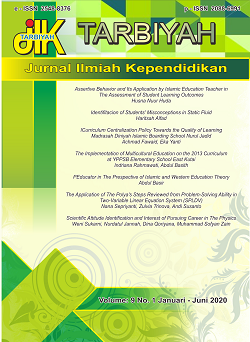Identification of Students' Misconceptions in Static Fluid
DOI:
https://doi.org/10.18592/tarbiyah.v9i1.3233Abstract
This study aimed to identify students’ misconceptions in static fluid covering Archimedes’ Principle and hydrostatic pressure. The used-instruments were of 10 multiple choice questions supported by reasons for answers. The method used in this research was giving the exercise in the form of questions to 32 students of XI class who had received subject matter of Archimedes’ Principle and hydrostatic pressure at middle and high school levels. The results of the students’ answers were then analyzed and presented qualitatively and quantitatively. Based on the analysis of students’ answers obtained 16 types of misconceptions in static fluid. In comprehending Archimedes' Principle, most students experienced difficulties in determining the state of floating, sinking and determining magnitude of buoyancy of objects in a fluid. While on hydrostatic pressure topic, most students found it difficult to determine the amount of hydrostatic pressure at a point in the fluid.References
Chen, L. H. (2011). Enhancement of student learning performance using personalized diagnosis and remedial learning system. Computers and Education. https://doi.org/10.1016/j.compedu.2010.07.015
Goszewski, M., Moyer, A., Bazan, Z., & Wagner, D. J. (2013). Exploring student difficulties with pressure in a fluid. AIP Conference Proceedings, 1513, 154–157. https://doi.org/10.1063/1.4789675
Loverude, M. E., Heron, P. R. L., & Kautz, C. H. (2010). Identifying and addressing student difficulties with hydrostatic pressure. American Journal of Physics, 78(1), 75–85. https://doi.org/10.1119/1.3192767
Loverude, Michael E., Kautz, C. H., & Heron, P. R. L. (2003). Helping students develop an understanding of Archimedes’ principle. I. Research on student understanding. American Journal of Physics. https://doi.org/10.1119/1.1607335
Ornek, F., Robinson, W., & Haugan, M. (2008). What Makes Physics Difficult. Science Education International, 18(3), 165–172.
Ünal, S., & Coştu, B. (2005). Problematic issue for students: Does it sink or float? In Asia-Pacific Forum on Science Learning and Teaching (Vol. 6). Retrieved from https://www.researchgate.net/publication/26411488
Wagner, D. J., Cohen, S., & Moyer, A. (2009). Addressing student difficulties with buoyancy. AIP Conference Proceedings, 1179, 289–292. https://doi.org/10.1063/1.3266739
Wagner, Doris J, Carbone, E., & Lindow, A. (2014). Exploring Student Difficulties with Buoyancy. 357–360. https://doi.org/10.1119/perc.2013.pr.077
Wong, D., Lim, C. C., Munirah, S. K., Foong, S. K., Hadjiachilleos, S., Valanides, N., … Yeary, S. A. (2016). Student and Teacher Understanding of Buoyancy. 0693(March 2016), 4–7. https://doi.org/10.1080/02635143.2013.811074
Yin, Y., Tomita, M., & Shavelson, R. (2008). Diagnosing and Dealing with Student Misconceptions: Floating and Sinking. Science Scope, 31(8), 34–39. Retrieved from https://www.questia.com/library/journal/1G1-179076820/diagnosing-and-dealing-with-student-misconceptions
Downloads
Published
How to Cite
Issue
Section
License
Authors retain copyright and grant the journal right of first publication with the work simultaneously licensed under a Creative Commons Attribution 4.0 International License that allows others to share the work with an acknowledgment of the work's authorship and initial publication in this journal.




